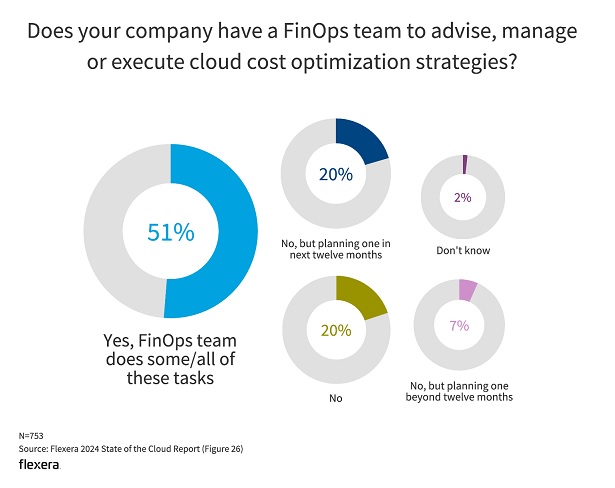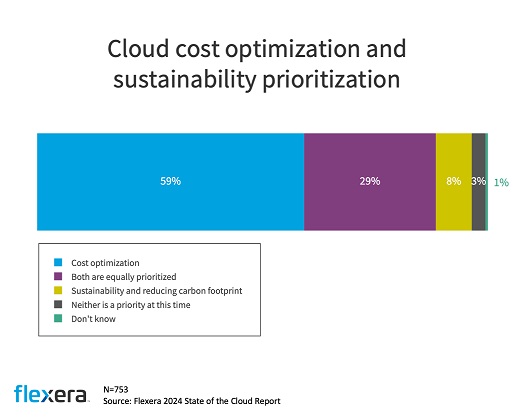In the fast-evolving realm of cloud computing, where innovation collides with fiscal responsibility, the Flexera 2024 State of the Cloud Report illuminates the challenges and triumphs shaping the digital landscape. This year's report is based on insights from more than 750 IT leaders and practitioners.
At the forefront of this year's findings is the resounding chorus of organizations grappling with cloud costs, with 71% of respondents intending to prioritize cost optimization in 2024. We've identified a pivotal issue: the struggle to adapt outdated processes to the dynamic cloud environment. As organizations start using the cloud, it's clear they need to keep up with new technology. Automation is emerging as a linchpin for driving efficiency and maximizing returns on investment.
However, alongside the call for innovation, there's the perennial challenge of balancing budget limits with the need to innovate. With organizations already exceeding public cloud budgets by 15%, IT leaders find themselves navigating a delicate tightrope walk. They're trying to make the most of the cloud's potential, while also being careful with their budgets.
While these findings aren't entirely unexpected, they form the foundation of challenges that leaders are grappling with. Amidst our exploration of these aspects, we encountered several data points that are unexpectedly intriguing.
1. A Revelation in Reducing Cloud Cost Waste – and Who's Responsible
Perhaps one of the most encouraging revelations from this year's report is the gradual decline in wasted cloud spend, dropping to 27%, the lowest percentage recorded over the past 13 years of our State of the Cloud reports. While this is only a self-estimate of wasted spend, it appears that the industry is seeing the benefits of having FinOps (cloud cost optimization) practices to manage their cloud costs.
This downward trend is a big moment for the cloud world, showing how effective FinOps methods are at cutting financial waste. FinOps practices are maturing; today 51% of organizations report utilizing a FinOps team and 20% report they will have one by next year.

The FinOps Foundation has done a tremendous job of creating a structured framework for organizations to optimize cloud spending, align resources with strategic objectives, and spark collaboration across their various business units. And it now feels as though we are truly entering a new era of fiscal responsibility and operational excellence in the cloud.
2. Traction Finally Comes to Sustainability Initiatives
Amid the focus on saving money, another narrative is emerging: sustainability in action. We've cited sustainability as something that has been on the radar of organizations for years. Now, with nearly half of all respondents (48%) reporting initiatives including tracking the carbon footprint of cloud usage, it feels like we are finally gaining traction in an incredibly important area.
But where exactly does sustainability fall when it comes to cloud priorities?
When asked how sustainability compares to cost optimization, 59% prioritized cost optimization, though an additional 29% say that both cloud cost optimization and sustainability are equally prioritized.

Perhaps it's expected that companies prioritize optimizing cloud costs over other initiatives like sustainability. Without real financial consequences for neglecting sustainability efforts, it often takes a backseat to budget concerns. This is why Europe stands out in this regard, as their strict sustainability regulations, like the European Sustainability Reporting Standards, enforce penalties for non-compliance. This may be reflected in a greater percentage of European respondents reporting that their organizations have defined sustainability initiatives that include carbon footprint tracking of cloud use (56% of European respondents, compared to 48% overall). Regardless of region, it's encouraging to witness this growth in sustainability initiatives among organizations.
3. Generative AI and the Need to Stay Nimble
This is a really complex year for cloud adoption. Organizations are investing in the aforementioned sustainability initiatives, as well as security, and now a massive investment in generative AI, all while prioritizing cost management. They all seem to counter each other, don't they?
Innovation is expensive, so it's up to IT leaders to figure out how to balance costs with the desire to remain on the cutting edge. The integration of generative AI (GenAI) into various systems and processes is increasing cloud workloads, adding new complexities to cost management, and raising legitimate concerns regarding potential security vulnerabilities and risks. And all of these efforts can throw a wrench into the best-intentioned cost optimization efforts.
The numbers provide the best way to gain a comprehensive view of where the priorities of IT leaders reside:
■ More than a quarter of respondents (29%) spend over $12 million a year on cloud and nearly a quarter (22%) spend that much on SaaS.
■ There's a 21% increase year-over-year in organizations spending $1 million or more per month on cloud.
■ Managing cloud spend ranked 1st as the top cloud challenge (84%), with security following behind it (81%) as the biggest challenge among respondents.
■ A quarter of respondents are already using GenAI extensively, 38% are experimenting, and 22% use it sparingly; 47% are using GenAI cloud services in some form.
So, where's the surprise in this?
Perhaps the biggest lightbulb moment here that isn't being spoken about is how IT leaders will need to pivot very quickly when taking speculative bets on generative AI. While some GenAI initiatives will likely show promise and tangible returns, many won't make good business sense; this is where business leaders must hold themselves accountable. When dealing with emerging technologies, leaders are going to need strict, swift assessment processes and good data in place to measure ROI. This will hopefully prevent runaway spending and keep security in check.


